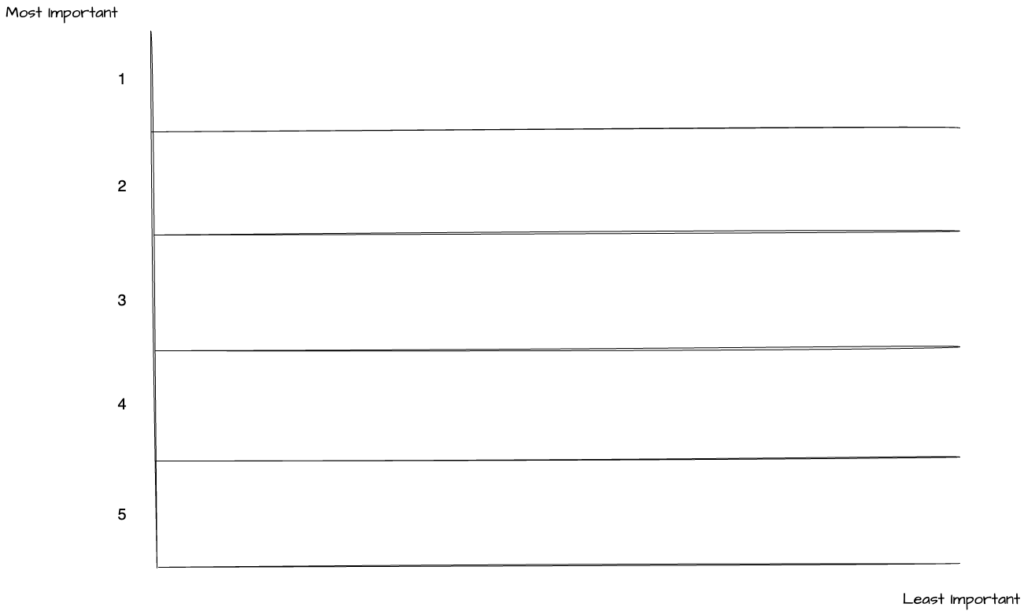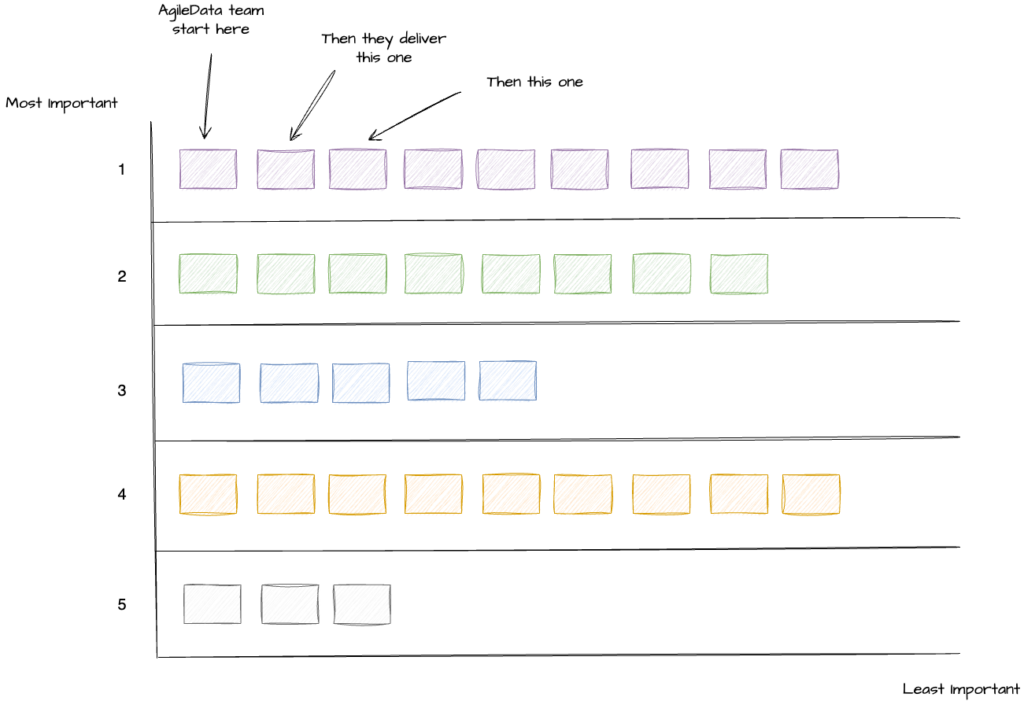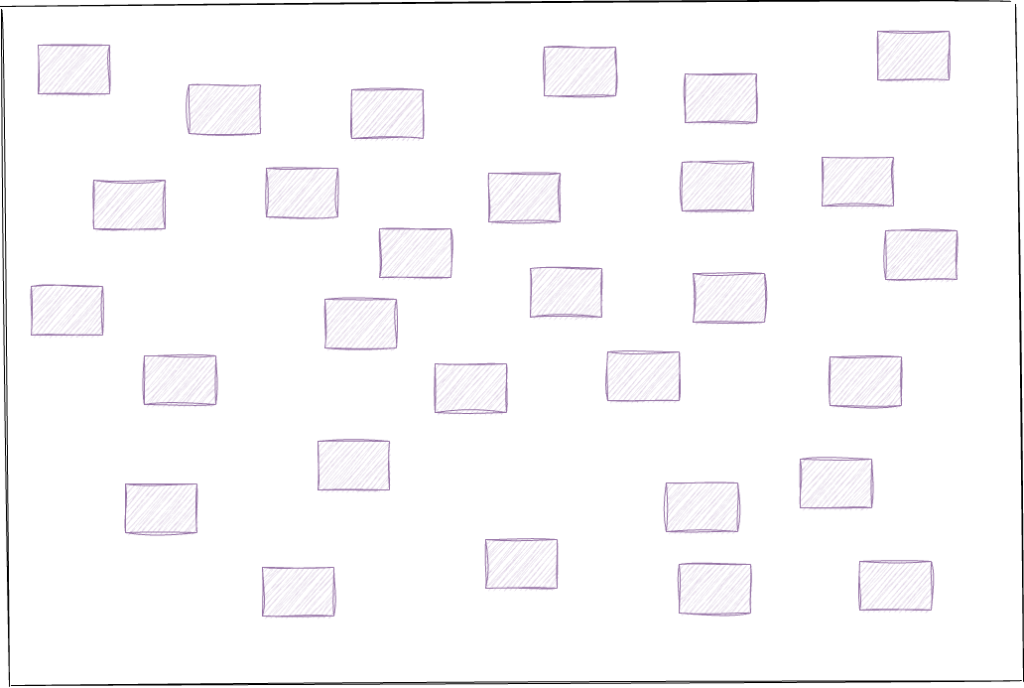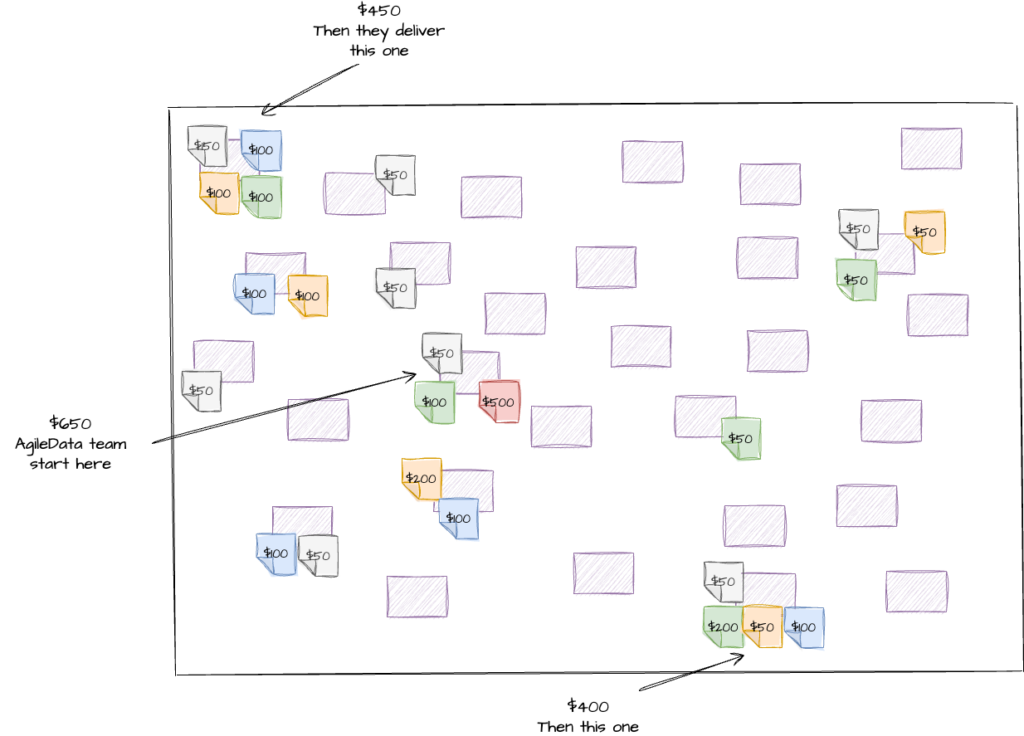There are a number of prioritisation patterns we have found in the agile and product domains which we have proven are useful when used to prioritise work in the data domain.
We use the Information Product Canvas and the Data Platform Press Releases as the inputs for these prioritisation patterns.
5 Lanes
This is one of our favourite patterns to help stakeholders define the priority of the data work to be delivered.
It can be used to prioritise both the Information Product Canvas and the Data Platform Press Releases, although the stakeholders who prioritise each of these may be different..
The 5 lanes pattern is based on the ABC Analysis pattern where we put in place a forcing function to ensure stakeholders cannot place the same prioritisation on multiple pieces of work.
We use this pattern to do an initial prioritisation of the entire Information Product or Data Platform backlog and then use it to iterate the priorities every two months.
Prioritisation Process
The first step is to set up a physical or virtual board with 5 lanes or rows on it. Number the rows from 1 to 5, with 1 at the top and 5 at the bottom.

This can be done using tape on a wall or tape on a large boardroom table (check first that the tape won’t take the paint off the wall or damage the table when you remove it). Or you can use a virtual environment such as Miro or Mural to create an electronic board with the 5 lanes..
The second step is to create cards, one for each Information Product Canvas or Data Platform Press Release that has been defined. These cards can either contain just the Information Product Name, or you may want to include a subset of the information from the canvas, for example the Product Owner name and T-shirt sizing or the Vision statement.
You need to provide enough information for the stakeholder to quickly glean what the Information Product is about. We will often use a card with just the Information Product name and then have copies of the Information Product Canvas readily available if the stakeholder needs more information.
Next you gather a group of stakeholders together to attend the prioritisation workshop and undertake the prioritisation process. These should be the people in the organisation who can make the prioritisation decisions, not people who have been delegated to attend the prioritisation workshop because the key stakeholders are too busy.
Once the stakeholders have gathered for the workshop, explain they are going to work together to prioritise the work that will be done over the next three months and that they will use the Information Product pattern to streamline the process. Explain what an Information Product Canvas is by talking them through one of the canvases.
Outline there are more Information Product Canvas defined than can be delivered within the current three month delivery window. We are focussed on prioritising the work that will be delivered over the next three months, but we will quickly prioritise all the Information Products in this initial workshop.
Another prioritisation workshop will be run in two months time to prioritise the following three months, and to ensure re-prioritisation can happen to reflect any changes in organisational priorities that have happened over that time. This pattern of re-prioritising the Information Product Canvas is rinsed and repeated every two months.
Ask the stakeholders to work together to place the cards for the most important Information Products at the beginning of lane 1 and the least important at the end of lane 5.
Information Product cards can go in any lane and anywhere in that lane. The AgileData team will start with the first Information Product / card on the left hand side of lane 1 and once that is delivered then start on the card immediately to the right.

There are two rules:
- Stakeholders cannot put cards on top of each other, if they have the same importance to an Information Product that is already in the lane, then they put the new card to either the left or right of the current card.
- All the cards must be placed in a lane
The polices are:
- Stakeholders can reorder any placed cards whenever they want, but it must be done in discussion with the other stakeholders.
- Stakeholders can shorten the prioritisation process by dumping all the low priority cards in Lane 5
- Lanes do not need to be filled, its ok to have a short lane 2 and a full lane 3.
- Stakeholders cannot bully other stakeholders.
- If there is a HIPPO in the room they should wait until the other Stakeholders have placed all the cards in Lanes and then move the Cards they care about telling the Stakeholders why they are moving that card.
If lane 1 becomes full with cards, then the next card that would have gone into the end of lane 1, gets placed at the beginning of lane 2. All the cards already in that lane get moved right to make space for the new card.
The process is completed when every Information Product card has been placed in a lane.
The entire prioritisation process should take less than two hours to complete. If you have a consistent set of stakeholders for each workshop, then you will find the process will take less time and less time as they become more familiar with the process.
5 Lanes Anti-Patterns
Pre-curate the lanes
You may be tempted to pre-curate the process by putting the cards into the lanes yourself, based on what you understand the priorities are or working with a single individual, such as the Product Owner to do this. Then have the prioritisation stakeholders review and confirm the priorities, or move things around.
Don’t.
The key to this pattern is the conversations about business value and trade-off compromises that happen when stakeholders start with a blank page. If you pre-seed the cards into the lanes, then these conversations tend to not happen, as stakeholders will give it a once over, maybe move one or two cards and then try and finish the session early to get back to their other pressing tasks. The power of the blank space forces the necessary conversations to be had.
500 Dollars
This is the second prioritisation pattern we use often to help stakeholders define the priority of the data work to be delivered in the near term delivery window, typically a 3 month window.
It can be used to prioritise both the Information Product Canvas and the Data Platform Press Releases, although the stakeholders who prioritise each of these may be different.
The $500 pattern is based on the Eisenhower Matrix pattern where we put in place a forcing function to ensure stakeholders identify a small number of things that are the highest priority and should be worked on next.
We use this pattern to prioritise the top three Information Products or Data Platform features to be delivered next and then use it to iterate the priorities once those three things have been delivered.
Prioritisation Process
The first step is to create cards, one for each Information Product Canvas or Data Platform Press Release that has been defined. These cards can either contain just the Information Product Name, or you may want to include a subset of the information from the canvas, for example the Product Owner name and T-shirt sizing or the Vision statement.
You need to provide enough information for the stakeholder to quickly glean what the Information Product is about. We will often use a card with just the Information Product name and then have copies of the Information Product Canvas readily available if the stakeholder needs more information.
The second step is to set up a physical or virtual board with all the Information Products or Data Platform Features cards on it.

Next you gather a group of stakeholders together to attend the prioritisation workshop and undertake the prioritisation process. These should be the people in the organisation who can make the prioritisation decisions, not people who have been delegated to attend the prioritisation workshop because the key stakeholders are too busy.
Once the stakeholders have gathered for the workshop, explain they are going to work together to prioritise the work that will be done over the next three months and that they will use the Information Product pattern to streamline the process. Explain what an Information Product Canvas is by talking them through one of the canvases.
Outline there are more Information Product Canvas defined than can be delivered within the current three month delivery window. We are focussed on only prioritising work that can be delivered over the next three months.
Another prioritisation workshop will be run in two months time to prioritise the following three months. This pattern of re-prioritising the Information Product Canvas or Data Platform Press Releases is rinsed and repeated every two months.
Next we provide the stakeholders with $500 of virtual money. If we are running an in person workshop we use Monopoly money, fake money from a dollar store or print out and cut out fake money. Only use the large denominations, don’t use the $1 or $5. If we are using a virtual board we either create post it notes with virtual currency ($10, $20, $50, $100) so stakeholders can copy and paste them, or we ask the stakeholders to use the text option to type in the amount next to each card.
Ask the stakeholders to place their fake money on the Information Product cards that are the highest value to them, until they have spent all their fake money.
The money can go on any card and they can place as much or as little money on as many cards as they want. The AgileData team will start with the first Information Product / card that has the highest amount of money assigned and once they have completed delivery of that Information Product they will start on the one with the next highest amount of money.

There is one Rule:
- Stakeholders are not allowed to touch other Stakeholders’ money.
The polices are:
- Stakeholders can put as much or as little money as they want on each card, putting $500 on one card is acceptable.
- Stakeholders do not need to spend the full $500
- Stakeholders can influence other stakeholders to spend money on the cards they think are the highest priority.
- Stakeholders cannot bully other stakeholders.
- If there is a HIPPO in the room they should place their money down last.
If there is a tie in terms of dollars, for example two cards both are the highest with $450, then the stakeholders can decide to do another round and move some of their money to change the priority. If there is still a tie for the highest priority then the AgileData team decides which one they will work on delivering first.
The process is completed when Stakeholders have either run out of fake money or have decided they will not spend anymore.
The entire prioritisation process should take less than one hour to complete. If you have a consistent set of stakeholders for each workshop, then you will find the process will take less time and less time as they become more familiar with the process.
